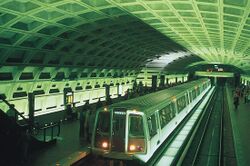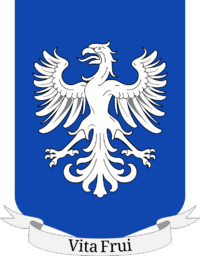New Phork Underground: Difference between revisions
No edit summary |
Philimania (talk | contribs) mNo edit summary |
||
| (6 intermediate revisions by one other user not shown) | |||
| Line 1: | Line 1: | ||
{{ | {{Region_icon_Philimania}} | ||
{{Infobox public transit | {{Infobox public transit | ||
|name = New Phork Underground | |name = New Phork Underground | ||
| Line 11: | Line 10: | ||
| transit_type = | | transit_type = | ||
{{wp|Rapid transit}} | {{wp|Rapid transit}} | ||
|began_operation = | |began_operation = 4 Tebax 1972<br />(New Phork Underground opened) | ||
|system_length = {{convert|434.3|km|mi|abbr=on}} | |system_length = {{convert|434.3|km|mi|abbr=on}} | ||
|lines = 9 | |lines = 9 | ||
|stations = 63 | |stations = 63 | ||
|ridership = 1.757 million | |ridership = 1.757 million | ||
( | (2000) | ||
|track_gauge = {{wp|standard gauge|1,435 mm}} (4 ft 8<sup>1</sup>⁄<sub>2</sub> in) ( | |track_gauge = {{wp|standard gauge|1,435 mm}} (4 ft 8<sup>1</sup>⁄<sub>2</sub> in) (1972–pres.) | ||
| operator = [[New Phork Underground Corporation]] | | operator = [[New Phork Underground Corporation]] | ||
| map = | | map = | ||
| Line 30: | Line 28: | ||
The '''New Phork Underground''' (also known simply as '''the Underground''') is a rapid transit system serving [[New Phork]] in [[Philimania]]. | The '''New Phork Underground''' (also known simply as '''the Underground''') is a rapid transit system serving [[New Phork]] in [[Philimania]]. | ||
Opened in | Opened in Tebax 1972, The network has expanded to 9 lines, and in 2000 was used for 641.305 million passenger journeys. The 9 lines collectively handle up to 1.757 million passenger journeys a day. | ||
Construction of the New Phork Underground was prompted by a study, released in 1970, commissioned by [[The Philimanian Legislative Council]] to find solutions to the increasing road congestion problem caused by the city's fast-growing poppulation. Construction started soon after the release of the study, and the first line opened in 1972. The New Phork Underground was immediately popular with residents of [[New Phork]]; as a result, subsequent lines have been built to cover more district. There are continual debates regarding how and where to expand the network. | Construction of the New Phork Underground was prompted by a study, released in 1970, commissioned by [[The Philimanian Legislative Council]] to find solutions to the increasing road congestion problem caused by the city's fast-growing poppulation. Construction started soon after the release of the study, and the first line opened in 1972. The New Phork Underground was immediately popular with residents of [[New Phork]]; as a result, subsequent lines have been built to cover more district. There are continual debates regarding how and where to expand the network. | ||
== History == | <!--== History == | ||
=== Initial proposals === | === Initial proposals === | ||
| Line 98: | Line 96: | ||
| style="text-align:right;" | 9 | | style="text-align:right;" | 9 | ||
| [[Spring-Oakley Interchange]]<br />[[Oakley-Capital Interchange]] | | [[Spring-Oakley Interchange]]<br />[[Oakley-Capital Interchange]] | ||
| | | {{wp|London Underground 1972 Stock|1972 Stock}} | ||
| style="text-align:right;" | 8 | | style="text-align:right;" | 8 | ||
| style="text-align:right;" | 195,200 | | style="text-align:right;" | 195,200 | ||
| Line 111: | Line 109: | ||
| style="text-align:right;" | 15 | | style="text-align:right;" | 15 | ||
| [[Oakley-Capital Interchange]]<br />[[Northeastern Interchange]] | | [[Oakley-Capital Interchange]]<br />[[Northeastern Interchange]] | ||
| | | {{wp|London Underground 1972 Stock|1972 Stock}} | ||
| style="text-align:right;" | 7 | | style="text-align:right;" | 7 | ||
| style="text-align:right;" | 345,800 | | style="text-align:right;" | 345,800 | ||
| Line 124: | Line 122: | ||
| style="text-align:right;" | 6 | | style="text-align:right;" | 6 | ||
| [[Spring-Oakley Interchange]]<br />[[Airport Line Terminus]]<br />[[Spring-Charingham Interchange]] | | [[Spring-Oakley Interchange]]<br />[[Airport Line Terminus]]<br />[[Spring-Charingham Interchange]] | ||
| | | {{wp|London Underground 1972 Stock|1972 Stock}} | ||
| style="text-align:right;" | 7 | | style="text-align:right;" | 7 | ||
| style="text-align:right;" | 115,300 | | style="text-align:right;" | 115,300 | ||
| Line 137: | Line 135: | ||
| style="text-align:right;" | 3 | | style="text-align:right;" | 3 | ||
| [[Foster International Airport]]<br />[[Airport Line Terminus]] | | [[Foster International Airport]]<br />[[Airport Line Terminus]] | ||
| | | {{wp|London Underground 1972 Stock|1972 Stock}} | ||
| style="text-align:right;" | 9 | | style="text-align:right;" | 9 | ||
| style="text-align:right;" | 19,900 | | style="text-align:right;" | 19,900 | ||
| Line 150: | Line 148: | ||
| style="text-align:right;" | 5 | | style="text-align:right;" | 5 | ||
| [[Northeastern Interchange]]<br />[[North-Reeds Interchange]] | | [[Northeastern Interchange]]<br />[[North-Reeds Interchange]] | ||
| | | {{wp|London Underground 1972 Stock|1972 Stock}} | ||
| style="text-align:right;" | 8 | | style="text-align:right;" | 8 | ||
| style="text-align:right;" | 120,200 | | style="text-align:right;" | 120,200 | ||
| Line 163: | Line 161: | ||
| style="text-align:right;" | 9 | | style="text-align:right;" | 9 | ||
| [[Northeastern Interchange]]<br />[[North-Reeds Interchange]]<br />[[Grunning-Reeds Interchange]] | | [[Northeastern Interchange]]<br />[[North-Reeds Interchange]]<br />[[Grunning-Reeds Interchange]] | ||
| | | {{wp|London Underground 1972 Stock|1972 Stock}} | ||
| style="text-align:right;" | 8 | | style="text-align:right;" | 8 | ||
| style="text-align:right;" | 322,800 | | style="text-align:right;" | 322,800 | ||
| Line 176: | Line 174: | ||
| style="text-align:right;" | 7 | | style="text-align:right;" | 7 | ||
| [[Northeastern Interchange]]<br />[[Grunning-Charingham Interchange]] | | [[Northeastern Interchange]]<br />[[Grunning-Charingham Interchange]] | ||
| | | {{wp|London Underground 1972 Stock|1972 Stock}} | ||
| style="text-align:right;" | 8 | | style="text-align:right;" | 8 | ||
| style="text-align:right;" | 230,600 | | style="text-align:right;" | 230,600 | ||
| Line 189: | Line 187: | ||
| style="text-align:right;" | 14 | | style="text-align:right;" | 14 | ||
| [[Charingham-Capital Interchange]]<br />[[Grunning-Charingham Interchange]]<br />[[Spring-Charingham Interchange]]<br />[[Gapan-Charingham Interchange]] | | [[Charingham-Capital Interchange]]<br />[[Grunning-Charingham Interchange]]<br />[[Spring-Charingham Interchange]]<br />[[Gapan-Charingham Interchange]] | ||
| | | {{wp|London Underground 1972 Stock|1972 Stock}} | ||
| style="text-align:right;" | 7 | | style="text-align:right;" | 7 | ||
| style="text-align:right;" | 234,900 | | style="text-align:right;" | 234,900 | ||
| Line 202: | Line 200: | ||
| style="text-align:right;" | 11 | | style="text-align:right;" | 11 | ||
| [[Gapan-Charingham Interchange]] | | [[Gapan-Charingham Interchange]] | ||
| | | {{wp|London Underground 1972 Stock|1972 Stock}} | ||
| style="text-align:right;" | 8 | | style="text-align:right;" | 8 | ||
| style="text-align:right;" | 172,300 | | style="text-align:right;" | 172,300 | ||
| Line 220: | Line 218: | ||
[[File:Ticketing-ascom-1024x683.jpg|thumb|Ticket and add-value machines]] | [[File:Ticketing-ascom-1024x683.jpg|thumb|Ticket and add-value machines]] | ||
=== Moreno | === Moreno card === | ||
The [[Moreno card]] is a rechargeable contactless smart card used in an electronic payment system in [[New Phork]] developed by the [[New Phork Underground Corporation]]. It was launched in July 2001 for use on the New Phork Underground and now is the most widely used electronic cash system for transactions in New Phork as many retailers (including supermarkets, car parks and fast food outlets) are fitted with readers. The technology used was Sony's {{wp|FeliCa|Felica}} line of smartcard. The Octopus card uses {{wp|radio frequency identification}} ({{wp|RFID}}) technology so that users need only hold the card in front of the reader, without taking it out of handbags and wallets. | |||
=== Tickets === | === Tickets === | ||
[[Category: | A touchless smart card system is used for single journey tickets. These tickets are pre-paid for between pre-determined stations, and are good for only one trip. There are no return tickets. As of mid-2019, less than three per cent of customers travelled on single journey tickets. | ||
Fares for the [[Airport Line]] are substantially different from main line fares. Apart from single tickets, same-day return tickets (same price as a single), and one-month return tickets are also available. | |||
== Performance == | |||
Since 1986, the New Phork Underground has consistently achieved a 99.9 per cent on-time rate, meaning 999 of every 1,000 passengers arrives at their destination within 5 minutes of scheduled time. This makes the New Phork Underground one of the most efficient rapid transit systems on the planet. the New Phork Underground must report all delays of more than eight minutes to the government. There were 69 reportable incidents in 2017. the New Phork Underground is fined [[Philimanian Dollar|P$]]314,475 for having delays of 30 minutes to an hour, with higher fines for longer delays. | |||
== Regulations and safety == | |||
According to the New Phork Underground By-laws, eating, drinking, or smoking are not allowed in the paid area of stations or in trains. Offenders will be fined up to P$2000. | |||
Various campaigns and activities are taken to help ensure that the New Phork Underground is a safe system to travel on. Poster campaigns displaying information on topics such as escalator safety are a common sight in all stations, and announcements are made regularly as safety reminders to travelling passengers. By-laws were also introduced to deter potentially dangerous actions on the New Phork Underground, such as the ban on flammable goods on and rushing into trains when the doors are closing. Penalties ranging from fines to imprisonment have been imposed for such offences. | |||
Police officers patrol the trains and stations, and police posts are available at some stations. The [[New Phork Police Force]] has a Railway District responsible for the New Phork Underground. Closed-circuit television cameras are installed in stations and on some of the newer trains. | |||
All lines has [[platform screen doors]] (PSDs), ordered from Swiss glass door manufacturer [[Dormakaba|Kaba Gilgen AG]], installed upon construction. These doors make platforms safer by preventing people from falling onto the rails. | |||
== Visual identity == | |||
The New Phork Underground visual identity, which includes logo, vehicle livery, signage, route maps and passenger information, was updated in 1991–1995 by Norman Limited, the Philimanian design consultancy founded by [[John Norman]].--> | |||
[[Category:New Cardiff]] | |||
{{Template:Philimaniatopics}} | |||
Latest revision as of 13:06, 9 December 2022
 A train on the Reeds Line | |
| Overview | |
|---|---|
| Locale | New Phork, Philimania |
| Transit type | Rapid transit |
| Number of lines | 9 |
| Number of stations | 63 |
| Daily ridership | 1.757 million (2000) |
| Website | www.npu.com.ph |
| Operation | |
| Began operation | 4 Tebax 1972 (New Phork Underground opened) |
| Operator(s) | New Phork Underground Corporation |
| Technical | |
| System length | 434.3 km (269.9 mi) |
| Track gauge | 1,435 mm (4 ft 81⁄2 in) (1972–pres.) |
| Electrification | 630 and 750 V DC fourth rail |
| Average speed | 33 km/h (21 mph) |
The New Phork Underground (also known simply as the Underground) is a rapid transit system serving New Phork in Philimania.
Opened in Tebax 1972, The network has expanded to 9 lines, and in 2000 was used for 641.305 million passenger journeys. The 9 lines collectively handle up to 1.757 million passenger journeys a day.
Construction of the New Phork Underground was prompted by a study, released in 1970, commissioned by The Philimanian Legislative Council to find solutions to the increasing road congestion problem caused by the city's fast-growing poppulation. Construction started soon after the release of the study, and the first line opened in 1972. The New Phork Underground was immediately popular with residents of New Phork; as a result, subsequent lines have been built to cover more district. There are continual debates regarding how and where to expand the network.
